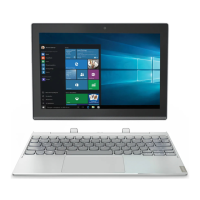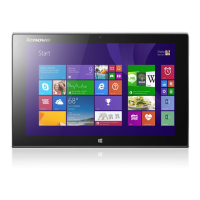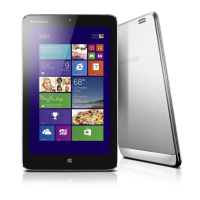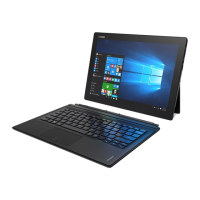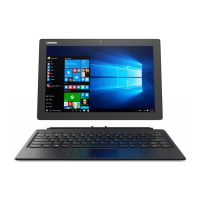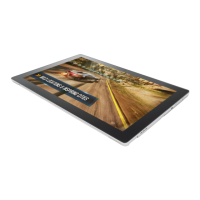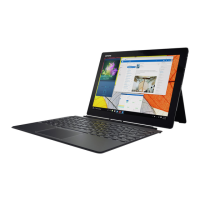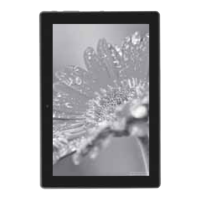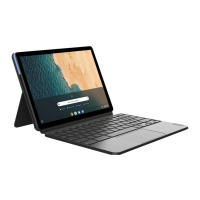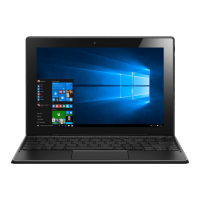
Do you have a question about the Lenovo ideapad MIIX 310-10ICR and is the answer not in the manual?
| Display Size | 10.1 inches |
|---|---|
| Resolution | 1280 x 800 pixels |
| Processor | Intel Atom x5-Z8350 |
| RAM | 2GB |
| Storage | 32GB or 64GB eMMC |
| Operating System | Windows 10 Home |
| Battery Life | Up to 10 hours |
| Front Camera | 2 MP |
| Rear Camera | 5 MP |
| Touchscreen | Yes |
| Wireless | WiFi 802.11 b/g/n, Bluetooth 4.0 |
| Ports | 1 x micro HDMI, 1 x micro USB |
| Card Reader | MicroSD |
| Processor Speed | 1.44 GHz (up to 1.92 GHz burst) |
| Dimensions | 246 x 173 x 9.2 mm (tablet only) |
| Wireless Connectivity | Bluetooth 4.0 |
| Weight | 580 grams (tablet only) |
Details the components visible from the top of the tablet, including cameras and antennas.
Explains how to rotate the display panel between portrait and landscape modes.
Identifies ports and features on the left side of the tablet, such as the combo audio jack and speaker.
Details the right side of the tablet, including buttons, ports, and indicators like power and card reader.
Step-by-step guide on how to insert micro SD and micro SIM cards into the device's card tray.
Instructions for safely removing micro SD and micro SIM cards from the device's card tray.
Shows the bottom of the tablet, highlighting the tablet-keyboard dock latch and connector.
Details the rear of the tablet, specifically the rear camera and its function.
Illustrates the top of the keyboard dock, showing keys, touchpad, and system status indicators.
Explains how to use function keys in combination with the Fn key for various shortcuts and features.
Identifies the USB 2.0 port located on the left side of the keyboard dock.
Identifies the USB 2.0 port located on the right side of the keyboard dock.
Explains how the tablet and keyboard dock combine to function as a notebook computer.
Provides instructions on how to carefully detach the tablet from the keyboard dock.
Guides users through initial setup steps like accepting EULA, setting up internet, and creating accounts.
Introduces the Windows 10 start menu and how to access it via keyboard or desktop.
Explains how to put the computer into sleep mode for short breaks and how to wake it up.
Provides steps to properly shut down the computer for longer periods of inactivity.
Covers managing tasks and virtual desktops in Windows 10, including creating and switching between them.
Guides users on enabling wireless connections and connecting to available wireless networks.
Introduces the Get Started app for learning about new Windows 10 features and how to launch it.
Details how to use the multi-touch screen, explaining common gestures like tap, press and hold, and zoom.
Explains the purpose of push-button reset as a recovery tool for restoring the OS to its original state.
Details the process of refreshing the computer to fix software problems by reinstalling the factory configuration.
Describes resetting the computer for recycling or ownership transfer, reinstating factory default configuration.
Outlines methods to launch push-button reset, including using hardware buttons or system settings.
Lists common questions related to finding information, hardware specifications, warranty, drivers, and getting help.
Addresses issues where the screen remains blank or goes blank while the computer is on.
Covers critical low-battery errors and the computer entering sleep mode immediately after power-on.
Covers issues such as blank, unreadable, or distorted screens and incorrect characters.
Addresses issues related to no sound output from speakers even when volume is up.
Addresses issues where the computer shuts down before the battery status icon shows empty, or operates when it shows empty.
Covers problems related to the Microsoft Windows operating system not starting.
Addresses failures to restore the system partition to its factory default state.
Covers general issues like the computer not responding and how to force shutdown.
